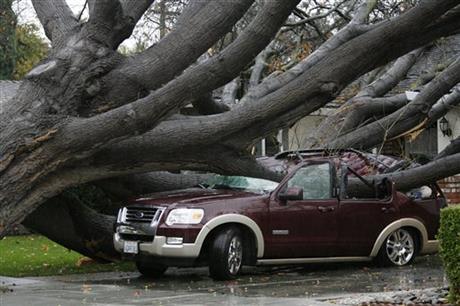
By OLGA R. RODRIGUEZ and ANDREW DALTON
A dangerous storm system blamed for two deaths in Oregon, thousands of power outages in Washington and flooded roadways in the Bay Area that kept many from work and school pushed into Southern California on Friday, causing mudslides and evacuations.
Avalanches of mud and debris blocked part of the Pacific Coast Highway in Ventura County, National Weather Service specialist Stuart Seto said.
He said heavy rain was falling in Ventura County as well as western Los Angeles County, where possible flash flooding was a concern.
The brunt of the storm was expected to move into the Los Angeles area shortly before dawn, Seto added.
Precautionary evacuations brought on by fear of mudslides began late Thursday in the Los Angeles suburb of Glendora, where the foothills were stripped bare by a major wildfire this year.
The storm’s powerful winds caused power outages around Santa Barbara and other parts of the coast, and forecasters predicted the winds would continue to pick up speed.
Denise George, who sells boats in Marina Del Rey, said that was her main worry.
“We make sure the halyards are secure, the canvases are fastened so nothing gets blown off or opened up, so yes, we are battening down the hatches, for sure,” George said.
On Thursday, the center of the storm and its torrential rains hit the San Francisco Bay Area and the surrounding region, pushing waterways toward flood stage, toppling trees and cutting power to thousands.
“It’s a big storm, as we expected, and it’s headed south with very powerful winds and heavy rainfall,” said National Weather Service meteorologist Will Pi.
In Oregon, the winds proved deadly. A falling tree killed a homeless man who was sleeping on a trail, and a teenage boy died after a large tree fell on the vehicle in which he was riding, causing it to swerve and hit another tree.
Falling trees also injured a man in southwest Washington and a sixth-grader at an elementary school in Santa Cruz, California.
The system’s powerful winds temporarily knocked out power to more than 150,000 customers in western Washington.
This Pineapple Express storm carried warm air and vast amounts of water in a powerful current stretching from Hawaii to the West Coast and up into the mountains, where gusts up to 140 mph blew through passes.
The current left San Francisco drenched but balmy, with 60-degree temperatures, about 5 degrees above average for this time of year.
Waves slammed onto waterfronts around the Bay Area, ferries were bound to their docks, airplanes were grounded and many schools and businesses told people to stay home.
The gusts made motorists tightly grip their steering wheels on the Golden Gate Bridge, where managers created a buffer zone to prevent head-on collisions by swerving cars.
The iconic suspension bridge is engineered to swing in cross winds, so “the concern we have right now is more about vehicles,” spokeswoman Priya David Clemens said.
Sonoma County authorities recommended that hundreds of people evacuate at least 300 homes in the lowest lying areas near the Russian River, which was expected to start overflowing overnight. Peak flooding in the towns of Guerneville and Monte Rio was anticipated by 10 a.m. Friday, forecasters said.
Authorities warned of minor flooding along the Sacramento River in Tehama County and Cache Creek in Yolo County.
Pacific Gas & Electric Co. crews worked to restore power to 110,000 people, down from 166,000 earlier Thursday.
There were multiple accidents on flooded roads, and several trees crunched cars. Interstate 5, California’s critical north-south thruway, was closed by flooding in the northern town of Weed. In Marin County, heavy rains washed out a portion of state Route 1.
Disembarking from a ferry in San Francisco, Malcolm Oubre said some people were overreacting.
“I know it’s a big storm supposedly, but they’re treating it like it’s a hurricane,” he said.
Teenagers drove trucks through a flooded Safeway parking lot to make waves for kayakers in Healdsburg as grocery shoppers trudged through several feet of water to get supplies.
East Coast kids revel in snow days, but closures are rare on the West Coast, so Thursday’s canceled classes were a novelty in San Francisco, Oakland, Berkeley, Sonoma and Santa Cruz County.
Surfers welcomed big, choppy swells from the same high seas that sent towering sprays of water airborne along breakfronts in San Francisco and Monterey.
Ski resorts in the northern Sierra Nevada — where schools and roads were closed by whiteout conditions and power outages — were hoping for 3 feet of snow once it all settles.
While rains were expected to continue through Friday evening across much of California, farmers will need more storms this size to even begin to recover from a record drought.
___
Rodriguez reported from San Francisco. Associated Press writers Martha Mendoza in Santa Cruz and Ellen Knickmeyer in San Francisco contributed to this report.



